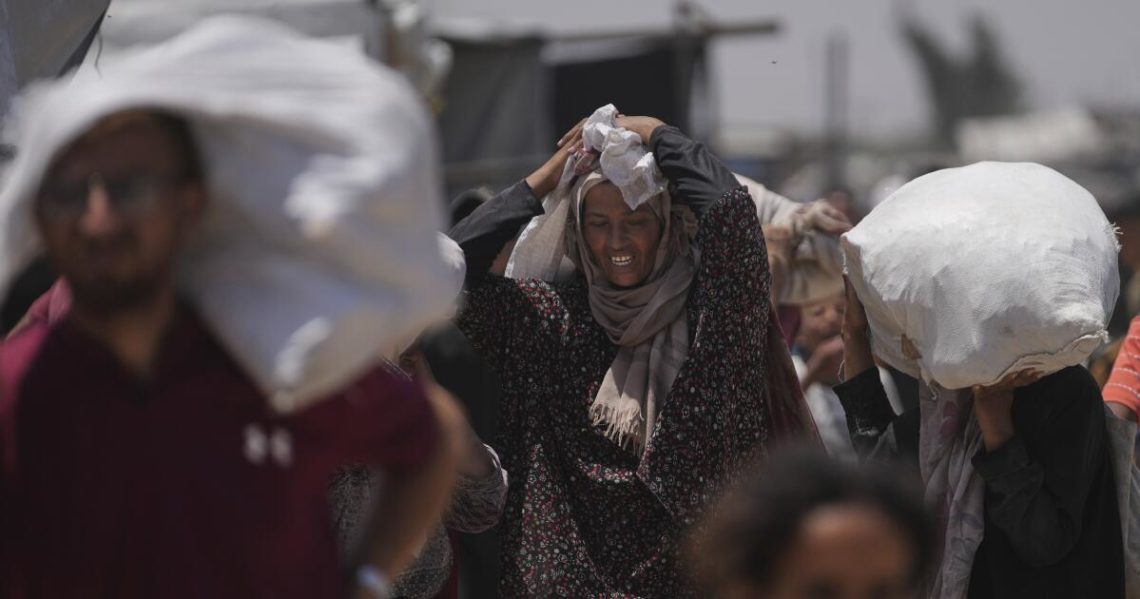DEIR AL BALAH, Gaza — Like “Squid Game.” That’s how residents describe it, invoking the dystopian TV show when recounting the lethal gauntlet that getting aid in famine-haunted Gaza has become.
“It’s a death race. The faster, the stronger, the luckier — they’re the ones who might survive, might reach the food,” said 30-year-old Mohammed al-Shaqra.
“It feels like we’re animals, racing for a box of supplies as if our lives depend on it. And they do.”
Ever since Israel sidelined the United Nations and other humanitarian organizations late last month and tasked assistance operations to the Gaza Humanitarian Foundation, an opaque U.S. and Israeli-backed private contractor registered in Delaware, killing has been the near-daily companion of aid deliveries.
On Thursday, health authorities in Gaza said 12 people were killed near a GHF distribution center, a relatively low toll in a week that saw 59 killed in similar circumstances on Tuesday. Since the foundation began its work on May 26, more than 400 people have been killed and more than 3,000 wounded.
Al-Shaqra became one of casualties this month.
On June 8, he gathered with thousands of others early in the morning near the GHF center in the southern Gaza city of Rafa. It was his third attempt to get food.
“I was desperate to bring something back — flour, rice, pasta, anything — for my parents, my siblings and their kids,” he said.
When the passageway to the distribution center opened, Al-Shaqra sprinted as fast as he could, hoping to beat others in the crowd and grab a box. But then an Israeli quadcopter drone — it had been buzzing above beforehand — started dropping explosives; the third bomb landed close to him, he said.
“My left arm shattered. I looked down and saw the bone hanging, and there was a sharp pain in my guts,” he said. Cradling his arm and trying to stop bleeding from his stomach, he stumbled for almost half a mile before collapsing onto a donkey cart. A kind driver took him to a field hospital for the International Community of the Red Cross. The doctors saved his arm.
The GHF came online two months after Israel cut off all aid entering into Gaza in March, justifying the blockade — despite widespread opprobrium — as a way to pressure Hamas into releasing hostages even as Palestinian authorities and aid groups reported a starvation crisis.
Although the U.N. and humanitarian organizations pleaded for access to feed the roughly 2 million people in the Gaza Strip, Israel insisted Hamas was stealing aid, a claim the U.N. and other groups deny and for which Israel has never provided evidence. The alternative, the Israeli government said, would be the GHF.
But the GHF was controversial from the outset, so much so that it first pick as executive director quit before aid deliveries even began, saying the foundation’s plan couldn’t be implemented without “breaching humanitarian principles.” Boston Consulting Group, which helped design the distribution system, terminated its contract with the GHF earlier this month and fired two partners involved with the project.
Instead of using humanitarian workers, the GHF has deployed armed private contractors with the Israeli military stationed only a hundred yards or so away. It also concentrated aid deliveries to what the GHF calls four “fortified” hubs in southern Gaza rather than the roughly 400 smaller centers used by the U.N. and other aid groups across the enclave — forcing already hungry people to walk for miles through active combat zones to access the deliveries.
Gaza residents also complain only one or two hubs are usually operating on any given day, and rarely open at the announced time. It’s also never stated what’s in the food boxes. And rather than directly handing the boxes to people, GHF workers instead dump them on pallets and watch crowds swarm over them. People gather hours in advance on safe routes designated by the Israeli military, but often find themselves under Israeli fire when allowed to approach the hubs.
“It’s a real-life version of ‘Squid Game.’ We run, then the shooting starts, we hit the ground and stay still so we’re not killed, then run again,” said Hussein Nizar, a resident who repeatedly tried to get aid, even after his neighbor Ameen Sameer was shot in the head.
“I watched him die beside me,” he said. “I couldn’t do anything to help out because of all the shooting.”
The Israeli military has repeatedly responded to questions about killings near GHF sites by saying it would look into reports of civilian casualties. In a previous incident, it said troops fired on people approaching them in a threatening manner.
Several Palestinians and a GHF spokesman — who gave his name as Majed — said many of the shootings occur when people run beyond the limits of the safe route in an attempt to get to the distribution site faster.
Even if they’re not wounded or killed, many go home empty-handed, said Jassim, a 28-year-old logistics worker hired by a local contractor working with the GHF.
“Decent people, especially the elderly and women with children, can’t fight through the crowds,” he said. He added that gangs also stalk people leaving the delivery area so as to rob them and sell the precious supplies on the black market.
“Many of them carry knives. It’s like a trap and I see many people killed.”
When Al-Shaqra regained consciousness, he found himself in Nasser Hospital, waiting for surgery in rooms already overflowing with other casualties from that day’s attacks at the GHF center. Among them was his father, Wadee al-Shaqra, who was injured by a bullet that tore through the side of his abdomen.
Wadee lost track of his son after he was shot, but found him hours later, by coincidence, in one of a few tents set up near Nasser Hospital for convalescing patients.
“I thought he was killed. I was so happy to see him I didn’t ask if he got any food. I didn’t care,” Wadee said. He added that he and Al-Shaqra went to the hubs despite the danger because they didn’t have enough bread to share among his grandchildren.
“We’re supposed to protect them,” he said. “We’re risking our lives just to keep them from starving.”
The GHF says its efforts have been a success, touting its delivery of almost 26 million “meals” in the 22 days since it started operations. But with almost half a million people facing catastrophic levels of hunger and the entire population contending with acute food security, according to the Integrated Food Security Phase Classification, the deliveries amount to roughly 0.6 meals per person.
The GHF does not elaborate on how it defines a meal, but it has previously stated that it calculated daily rations at 1,750 calories, well below the 2,200 calories target used by humanitarian organizations. (Majed said recent aid deliveries provide 2,500-calorie provisions.)
The bedlam accompanying GHF’s distribution practices, aid workers say, was entirely predictable.
“Delivery of humanitarian aid can be a very straightforward operation, but it’s a complex one,” said Juliette Touma, communications director for the U.N. agency for Palestinians, UNRWA.
She added that UNRWA and other groups have decades of experience serving Palestinians, with comprehensive registry lists and an orderly distribution system that assigns appointments at conveniently placed centers. The GHF aid, comprising mostly dry goods, such as pasta or lentils, requires gas and water to cook, both of which are hard to procure in Gaza. GHF aid also does not include hygiene and cleaning supplies, she said — an essential requirement.
“There’s this sheer arrogance that the U.N. and humanitarians can be replaced — just like that — by a third party, a private security company. It’s not at all like that,” she said. “Let us do our job.”
Saleem al-Najili, a 33-year-old nurse at the UK-Med Field Hospital in Deir al Balah, now dreads GHF delivery times.
“Every time the GHF center opens its doors, I know what’s coming,” he said.
“It means more blood and screaming, more impossible decisions on whom we can treat. And fewer people we can actually save.”
Shbeir, a Times special correspondent, reported from Deir al Balah. Times staff writer Bulos reported from Beirut.
The post ‘Death race’ for food: Hundreds killed in Gaza aid chaos appeared first on Los Angeles Times.




